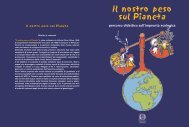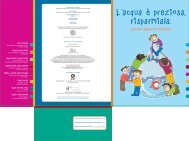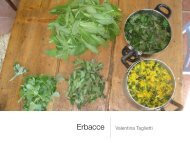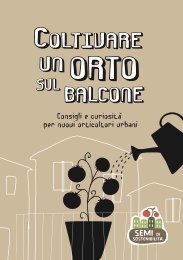Myanmar Protected Areas: Context, Current Status ... - Istituto Oikos
Myanmar Protected Areas: Context, Current Status ... - Istituto Oikos
Myanmar Protected Areas: Context, Current Status ... - Istituto Oikos
Create successful ePaper yourself
Turn your PDF publications into a flip-book with our unique Google optimized e-Paper software.
INLAY LAKE<br />
Site ID 11<br />
Locality<br />
Coordinates N20°13, E96°56’<br />
Size (km²) 642<br />
Altitude (m. asl) 830 -1,270<br />
<strong>Myanmar</strong> category Wildlife Sanctuary<br />
IUCN category IV<br />
Shan State (Nyaung Shwe, Pinlaung and Peh Kon<br />
Townships)<br />
Site Governance Nature and Wildlife Conservation Division<br />
Boundaries Demarcated<br />
Year gazetted 1985<br />
Protection level Partial (Fishing and Agriculture allowed)<br />
Main purposes<br />
Habitat Wetland, Hill Forest<br />
Conservation, Natural resources maintenance,<br />
Cultural heritage, Recreation/Ecotourism<br />
Key resources Wetland Ecosystem; Migratory birds<br />
Legend of topographic maps<br />
Head Quarters<br />
Ranger Post<br />
Towns<br />
<strong>Protected</strong> <strong>Areas</strong><br />
State/Region Boundaries<br />
Roads<br />
Water areas<br />
Rivers<br />
Elevation<br />
5.800 m. asl<br />
0 m. asl<br />
Legend of satellite maps<br />
Water Depth Vegetation Density<br />
Deep<br />
Shallow<br />
High<br />
Low<br />
SITE DESCRIPTION<br />
The site is located on the Shan plateau of East <strong>Myanmar</strong>, in<br />
the Thanlwin river basin. The natural lake is fairly shallow<br />
and is located in a broad valley between two limestone<br />
ridges rising up to 1,200 m asl and covered by hill forest. The<br />
wetland sanctuary has been established to protect migratory<br />
birds and their habitats. It is famous for its traditional floating<br />
agriculture and it is also a major source of hydropower for<br />
<strong>Myanmar</strong>.<br />
NATURAL RESOURCES<br />
The key resource of the site is a large population of many<br />
migratory and resident birds (according to the Park staff, 175<br />
species have been recorded), besides native aquatic plants<br />
and freshwater fishes.<br />
MANAGEMENT<br />
Annual operation plan<br />
Buffer zone proposed<br />
Management actions in place:<br />
• Patrolling<br />
• Census of aquatic species and resident and migratory bird<br />
species<br />
• Plantations outside the PA<br />
• Environmental education activities with schools<br />
• Community forestry outside<br />
<strong>Myanmar</strong> <strong>Protected</strong> <strong>Areas</strong><br />
Management problems:<br />
• Budget constraints<br />
Actions required:<br />
• Zone management<br />
• Equipment maintenance<br />
STAFF / RESOURCES<br />
The human resources (13 staff) are barely sufficient to manage<br />
the site. More foresters are needed to carry out conservation<br />
activities on the surrounding slopes. Many infrastructures<br />
are present, such as office, ranger posts and a bird watching<br />
centre, and equipment is provided. Staff has a different level<br />
of training in environmental issues and computer literacy is<br />
higher than elsewhere.<br />
Access to the site is easy due to the presence of motor roads<br />
around the lake and boat transportation inside.<br />
TOURISM<br />
Inlay Lake is one of <strong>Myanmar</strong> ecotourism sites and ASEAN<br />
heritage site. It is visited every year by a large number of local<br />
and foreign visitors. Cultural highlights are the traditional<br />
Intha leg-rowing, fishing techniques, floating cultivations,<br />
traditional weaving and tobacco production, as well as<br />
important pagodas. Many accommodation and lodging<br />
facilities are provided around the lake as well as trekking<br />
opportunities in the surrounding hills. Community-based<br />
tourism options are available.<br />
38 39<br />
THREATS<br />
The site is in a state of environmental emergency. Poor<br />
agricultural practices based on the inappropriate use of<br />
chemical fertilizers and pesticides are polluting the water.<br />
The growing tourism industry is an increasing threat to<br />
water quality due to the growing facilities that have been<br />
built inside and outside the protected area without due<br />
respect to environmental issues. Zoning recommendations<br />
are not respected by local fishermen that are increasingly<br />
abandoning traditional practices. Soil erosion in the<br />
surrounding slopes, which have been largely converted to<br />
agriculture, is the main cause of a severe sedimentation in<br />
the water body. All this is resulting in the alarming lowering<br />
of the water level and of its quality.<br />
Poaching, the collection of firewood and housepoles,<br />
gathering orchids, traditional gold mining are localized<br />
threats considered to be of limited impact.<br />
LAND USE AND HUMAN ACTIVITIES<br />
• Agricultural production<br />
• Fisheries production<br />
• Recreation<br />
Floating plantations (tomato, flowers) and fishing represent<br />
the main income-generation strategy for the local<br />
communities. Tourism is a boost for the local economy.<br />
RESEARCH<br />
Yangon University in collaboration with BANCA studied<br />
the sedimentation of the site and the use of pesticides.<br />
Taunggyi University studied the plankton.






